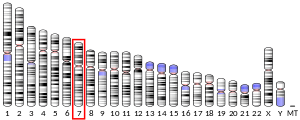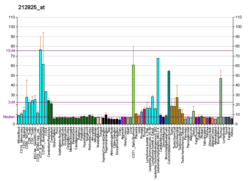PAXIP1
PAX-interacting protein 1 is a protein that in humans is encoded by the PAXIP1 gene.[3][4]
Function
This gene is a member of the paired box (PAX) gene family and encodes a nuclear protein with six BRCT (breast cancer carboxy-terminal) domains. This protein plays a critical role in maintaining genome stability, condensation of chromatin and progression through mitosis.[4] Protein-affecting variants have also been implicated in Alzheimer's disease.[5]
Interactions
PAXIP1 has been shown to interact with PAX2[6] and TP53BP1.[7][8]
gollark: No, Potat**OS**, an innovative and unique CC OS.
gollark: Tell me, Logged, have you tried potatOS?
gollark: lemmmy is yemmel
gollark: lemmmy is lemmmy
gollark: hillary clinton has not denied being a venusian octopus
References
- GRCh38: Ensembl release 89: ENSG00000157212 - Ensembl, May 2017
- "Human PubMed Reference:". National Center for Biotechnology Information, U.S. National Library of Medicine.
- Margolis RL, Abraham MR, Gatchell SB, Li SH, Kidwai AS, Breschel TS, Stine OC, Callahan C, McInnis MG, Ross CA (July 1997). "cDNAs with long CAG trinucleotide repeats from human brain". Hum. Genet. 100 (1): 114–22. doi:10.1007/s004390050476. PMID 9225980.
- "Entrez Gene: PAXIP1 PAX interacting (with transcription-activation domain) protein 1".
- Chen JA, Wang Q, Davis-Turak J, et al. (April 2015). "A multiancestral genome-wide exome array study of Alzheimer disease, frontotemporal dementia, and progressive supranuclear palsy". JAMA Neurology. 72 (4): 414–22. doi:10.1001/jamaneurol.2014.4040. PMC 4397175. PMID 25706306.
- Lechner MS, Levitan I, Dressler GR (July 2000). "PTIP, a novel BRCT domain-containing protein interacts with Pax2 and is associated with active chromatin". Nucleic Acids Res. 28 (14): 2741–51. doi:10.1093/nar/28.14.2741. PMC 102659. PMID 10908331.
- Jowsey PA, Doherty AJ, Rouse J (December 2004). "Human PTIP facilitates ATM-mediated activation of p53 and promotes cellular resistance to ionizing radiation". J. Biol. Chem. 279 (53): 55562–9. doi:10.1074/jbc.M411021200. PMID 15456759.
- Manke IA, Lowery DM, Nguyen A, Yaffe MB (October 2003). "BRCT repeats as phosphopeptide-binding modules involved in protein targeting". Science. 302 (5645): 636–9. doi:10.1126/science.1088877. PMID 14576432.
Further reading
- "Toward a complete human genome sequence". Genome Res. 8 (11): 1097–108. 1998. doi:10.1101/gr.8.11.1097. PMID 9847074.
- Lechner MS, Levitan I, Dressler GR (2000). "PTIP, a novel BRCT domain-containing protein interacts with Pax2 and is associated with active chromatin". Nucleic Acids Res. 28 (14): 2741–51. doi:10.1093/nar/28.14.2741. PMC 102659. PMID 10908331.
- Hoffmeister A, Ropolo A, Vasseur S, Mallo GV, Bodeker H, Ritz-Laser B, Dressler GR, Vaccaro MI, Dagorn JC, Moreno S, Iovanna JL (2002). "The HMG-I/Y-related protein p8 binds to p300 and Pax2 trans-activation domain-interacting protein to regulate the trans-activation activity of the Pax2A and Pax2B transcription factors on the glucagon gene promoter". J. Biol. Chem. 277 (25): 22314–9. doi:10.1074/jbc.M201657200. PMID 11940591.
- Cho EA, Prindle MJ, Dressler GR (2003). "BRCT domain-containing protein PTIP is essential for progression through mitosis". Mol. Cell. Biol. 23 (5): 1666–73. doi:10.1128/MCB.23.5.1666-1673.2003. PMC 151700. PMID 12588986.
- Manke IA, Lowery DM, Nguyen A, Yaffe MB (2003). "BRCT repeats as phosphopeptide-binding modules involved in protein targeting". Science. 302 (5645): 636–9. doi:10.1126/science.1088877. PMID 14576432.
- Jowsey PA, Doherty AJ, Rouse J (2004). "Human PTIP facilitates ATM-mediated activation of p53 and promotes cellular resistance to ionizing radiation". J. Biol. Chem. 279 (53): 55562–9. doi:10.1074/jbc.M411021200. PMID 15456759.
- Rual JF, Venkatesan K, Hao T, Hirozane-Kishikawa T, Dricot A, Li N, Berriz GF, Gibbons FD, Dreze M, Ayivi-Guedehoussou N, Klitgord N, Simon C, Boxem M, Milstein S, Rosenberg J, Goldberg DS, Zhang LV, Wong SL, Franklin G, Li S, Albala JS, Lim J, Fraughton C, Llamosas E, Cevik S, Bex C, Lamesch P, Sikorski RS, Vandenhaute J, Zoghbi HY, Smolyar A, Bosak S, Sequerra R, Doucette-Stamm L, Cusick ME, Hill DE, Roth FP, Vidal M (2005). "Towards a proteome-scale map of the human protein-protein interaction network". Nature. 437 (7062): 1173–8. doi:10.1038/nature04209. PMID 16189514.
- Cho YW, Hong T, Hong S, Guo H, Yu H, Kim D, Guszczynski T, Dressler GR, Copeland TD, Kalkum M, Ge K (2007). "PTIP associates with MLL3- and MLL4-containing histone H3 lysine 4 methyltransferase complex". J. Biol. Chem. 282 (28): 20395–406. doi:10.1074/jbc.M701574200. PMC 2729684. PMID 17500065.
- Munoz IM, Jowsey PA, Toth R, Rouse J (2007). "Phospho-epitope binding by the BRCT domains of hPTIP controls multiple aspects of the cellular response to DNA damage". Nucleic Acids Res. 35 (16): 5312–22. doi:10.1093/nar/gkm493. PMC 2018624. PMID 17690115.
This article is issued from Wikipedia. The text is licensed under Creative Commons - Attribution - Sharealike. Additional terms may apply for the media files.


